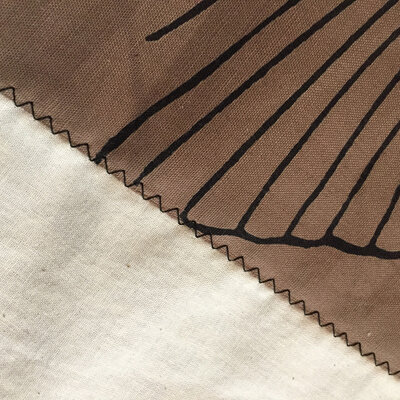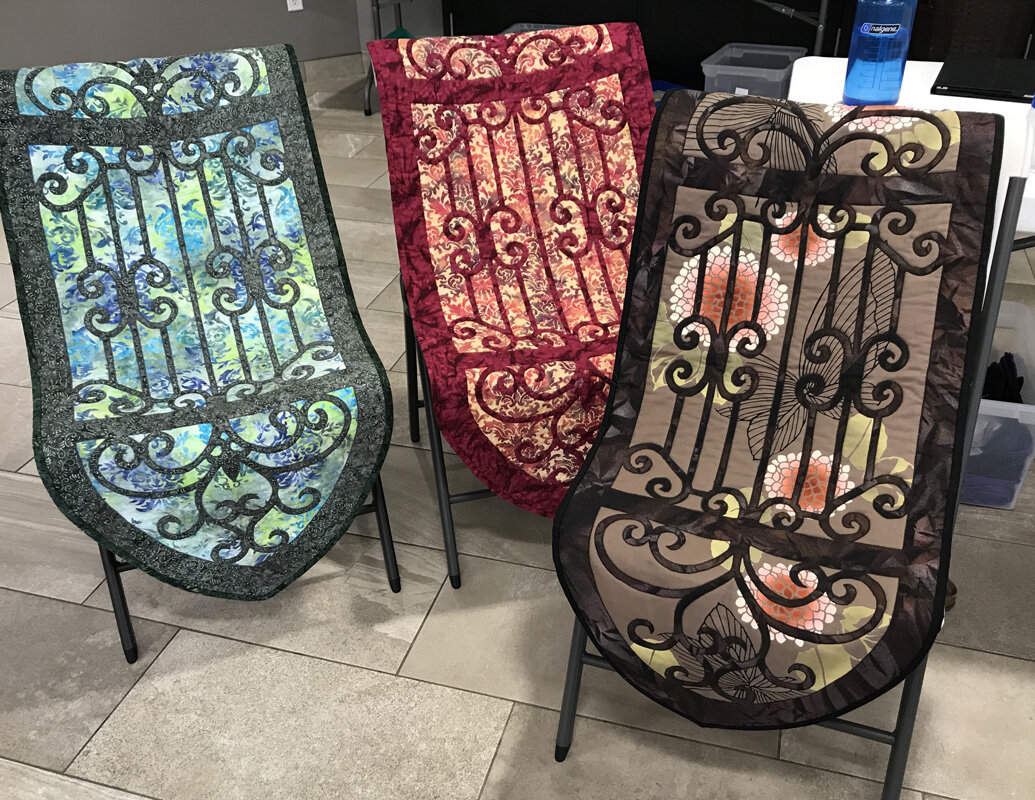Karen's Hospitality - West meets East
Carol Ziogas in her KimonoMomo booth at the quilt show when we met in 2015.
I don’t know about you, but I am inspired by fabric to make a particular design. It was the unique Japanese textiles I found at KimonoMomo that inspired this creative journey of remaking Karen’s Hospitality table runner IV. I invite you to join me on the journey.
It was a journey that began in 2015 in Albuqurque, NM at a quilt show. Perhaps you have seen KimonoMomo at quilt shows, too. I’m a sucker for out of the ordinary fabrics and am curious about how they will work in our patterns. I stumbled into their booth and “discovered” the traditional Yukata cotton, ikat and silk panels. I am no expert, but owner Carol Ziogas is. Part of what makes the vintage textiles I purchased unique is that they are woven 14-15” wide instead of our customary US 44” wide. They were created, if I remember correctly, for making Kimonos. The designs are painted on with a 39” repeat as a mirror image; all asymmetrical works of art by themselves…simple, elegant, exquisitely beautiful.
So, in true quilter fashion, and because my creative juices were flowing, I bought several panel pieces as I was brainstorming how I might use them. I brought home 2 pieces that were 14” x 39” and 3 pieces that were 15” x 78”, plus an ikat, a silk piece and some yard goods. The pattern designs needed to be chosen carefully to highlight the panels and create a piece that was an integrated whole. Because of their narrow width I was thinking of my table runners: Hearts & Fleurs, Enchanted Evening, Karen’s Hospitality. (Now, because I’ve designed more table runners, there are more possibilities to consider.) As an aside, these panels also would be fabulous for longarmers to stitch, I think.
14” x 39”. I ruled this out because it was too short. I needed 41”. I think this could work as top fabric for Hearts & Fleurs.
14” x 39”. I ruled this out because it was too short. I needed 41”. It has possibilities as background for Enchanted Evening.
15” x 78”. Still haven’t decided on this one, but it’s simply beautiful.
15” x 78”. I didn’t have the right fabric in my stash for the top fabric. Now I think it could look lovely as the top fabric in a resized Vintage Jewel which wasn’t designed until 2016.
When I’m at a show I’m always inspired. I also have all that driving time for my mind to wander and mentally create. I can’t tell you how many patterns I design and quilts I plan and make in my head as I drive only to arrive home to be hit with the time constraints of running the business and of life. I always think I’ll have the time to make “extra” projects and then I get home and reality sets in.
However, in the back of my head I was working on this Japanese table runner, and when I could steal a moment I would pull out the panels, my table runner pattern pieces and brainstorm. Depending on the pattern I used, these panels might be the top fabric or the background. It just depended on where each fabric’s design hit each pattern’s design, envisioning all the while. I also went through my stash of other lovely unique fabrics to select something to go with these panels.
Karen’s Hospitality table runner IV pattern, Dark Brown Airbrushed top fabric, light brown Yukata panel for background fabric.
I had a beautiful air-brushed deep brown fabric by DyeSmithy, which worked beautifully with the soft brown Yukata panel I had purchased so I decided to start with that combination. The panel had black outlines of butterflies and coral pink chrysanthemums. I also settled upon the Karen’s Hospitality table runner IV pattern. In the interest of time, I decided to make the piece by our trace, snip iron & stitch process for machine reverse applique. The Yukata panel would be the background fabric and the dark brown wrought iron gate top fabric. I could totally envision the flowers and butterflies peeking out through the wrought iron gate posts. The pattern would allow the panel to be highlighted, creating a table runner that was an integrated whole.
There was a problem, though. The pattern was too big for the panel. The finished dimensions of Karen’s Hospitality are 20” x 52 1/2”. The pattern has a border frame built into it. Inside this frame (white on the pattern piece) is where the background fabric is going to show. The problem was that the inside, from frame to frame, is 16” wide x 43” long, and my panel was only 15” wide. The length wasn’t a problem because my fabric was 78” long.
resized pattern on left, original pattern on right.
So I took my pattern piece to Kinkos to resize it. Kinkos has propotional scales available to help you figure out your resizing percentages, and the scale tells you how to use it right on it.
So using the proportional scale I figured out how much I needed to reduce my pattern to make it work. Following the directions on the scale, I took the 14” dimension as my panel dimension (so there would be some underlap with the frame), and lined that dimension up with the 16” dimension of the original pattern’s frame dimension. The proportional scale told me I needed to print my pattern at 88% of the original size, which I did. My resized Karen’s Hospitality would finish at 17 5/8” x 46 ¼”. My new internal frame dimensions were 14 1/8” x 41”.
Back at home I prepared my background fabric. For our patterns we need a piece of background fabric the same size as the top fabric. I cut a piece of muslin 20” x 49” and centered the Japanese panel on the muslin from side to side. I also placed the panel on the muslin so the fabric design would peek artistically through the gate of the pattern vertically. Once satisfied I zig-zagged the edges of the panel onto the muslin. Now my background fabric was big enough. The other thing accomplished by doing this is I didn’t lose any of my beautiful panel under the top fabric except just enough to keep the zig-zag stitching hidden. I folded the background in half lengthwise and widthwise to find the quarter marks, being sure I was finding the middle of the panel, and ironed in the folds. These I would use later when positioning the fused, cut out top fabric.
positioning the panel on the muslin to make the background fabric larger.
Zig-zagged edges of the panel to the muslin.
Next I simply followed the pattern’s directions for making Karen’s Hospitality by machine: 1. I traced the design onto the paper side of my Soft Fuse. 2. I ironed the Soft Fuse with the design traced onto it onto the wrong side of the top fabric. 3. I used my Kai sharp-tipped, bent-handled scissors to cut out what was white on the pattern and discarded those cut outs. 4. I peeled the paper off the fused top fabric and carefully positioned the top fabric, using the quarter marks, on the background fabric. 5. Then I ironed the top fabric to the background fabric.
I decided to Appli-quilt this piece, so I layered the top with my batting and backing. I was ready to go to my sewing machine and satin stitch the edges. Because the piece was already layered, the stitching would also be the first round of quilting. When you are Appli-quilting, you can go ahead and add the binding even before you finish the quilting as it’s all secure.
In process of Machine reverse appliqueing the piece. I used a 1.5 mm/.4mm satin stitch to cover the raw edges.
I chose a solid black batik for my binding.
Then I added more quilting. I went about quilting in the background fabric taking cues from the panel itself. I went around the petals of the chysanthemums and outlined the leaves. Then I went in between the black lines of the butterflies. From there I filled the remaining background with lines 1/4” apart. I used monofilament thread because I just wanted texture, without any added color. Because I appli-quilted the piece I did not need to quilt in the ditch around the reverse applique.
I love everything about how this piece came together. It was a fun creative journey of West meeting East.
While they last, I’m offering my extra Japanese Yukata panels on the website for sale. They are in our shop on the notions page. If you want some other options, KimonoMomo also has a limited selection in their Etsy shop.
My 3 versions of Karen’s Hospitality table runner.
Perhaps Japanese panels aren’t your thing. Consider one of the beautiful garden or butterfly panels on the market. Imagine the possibilities of how they would look peeking out of the wrought iron gate of Karen’s Hospitality. My original Karen’s Hospitality samples used fabrics that were more like wall-paper as the background fabric, which also worked very beautifully.
Whichever direction you go I hope this blog has inspired you. And perhaps you have learned how to use the proportional scale as well in case you want to make another pattern larger or smaller. The scale works both ways.
Remember, dear quilting friends, quilting is a creative act of hope. And hope is needed now more than ever in these crazy times we are living in. Remember to feed your soul with something beautiful. You need beauty as much as you need food.
Be safe, stay healthy and Happy quilting!
















